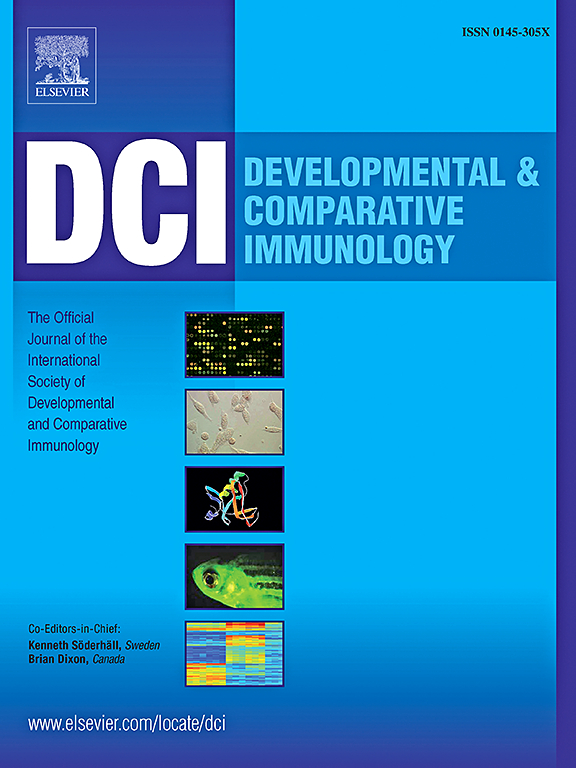东方对虾Mnlrig-1参与睾丸生殖免疫的鉴定
IF 2.4
3区 农林科学
Q1 FISHERIES
引用次数: 0
摘要
睾丸具有高度组织化的睾丸微环境,以支持精子发生。然而,甲壳类动物对其了解有限。在这项研究中,我们从鳙鱼睾丸中鉴定出了一种免疫球蛋白超家族(IgSF)成员,并探讨了它作为一种潜在的模式识别受体(PRR)参与生殖免疫的作用。根据其包含的结构域和同源性分析结果,我们将其命名为富含亮氨酸重复序列和免疫球蛋白样结构域蛋白-1(MnLrig-1)。Mnlrig-1由一个3288 bp的开放阅读框(ORF)组成,编码1095个氨基酸的蛋白质。MnLrig-1 由一个信号肽、一个 LRR_NT 结构域、八个 LRR 结构域、五个 LRR_TYP 结构域、一个 LRR_CT 结构域、三个 IGc2 区域、一个跨膜区域和 C 端胞质尾部组成,与其他甲壳类物种的同源物具有相似的结构域。MnLrig-1在M. nipponense的各种组织中广泛表达。Mnlrig-1在睾丸受到LPS、PGN、嗜水气单胞菌和藻溶弧菌挑战3小时后被显著诱导,并在3小时至24小时内保持较高水平。此外,MnLrig-1获得了两个重组免疫球蛋白结构域,但只有一个结构域在体外与LPS、PGN、大肠杆菌、嗜水气单胞菌、金黄色葡萄球菌和枯草杆菌直接结合。此外,沉默 Mnlrig-1 会导致睾丸中的三种抗脂多糖因子(ALFs)显著上调。这些结果揭示了MnLrig-1作为一种PRR参与乳头瘤病毒睾丸生殖免疫的潜在作用。这项研究将拓展我们对甲壳类动物免疫系统的认识,并可能对甲壳类动物的水产养殖和疾病管理产生影响。本文章由计算机程序翻译,如有差异,请以英文原文为准。
Identification of a Mnlrig-1 involved in testis reproductive immunity in the oriental river prawn Macrobrachium nipponense
The testis evolves a highly organized testicular microenvironment to support spermatogenesis. However, the knowledge about it is limited in crustacean. In this study, we identified a member of immunoglobulin superfamily (IgSF) from Macrobrachium nipponense testis and explored its roles as a potential pattern recognition receptor (PRR) involved in reproductive immunity. Based on the domains it contains and homology analysis result, we designate it as leucine-rich repeats and immunoglobulin-like domains protein-1 (MnLrig-1). The Mnlrig-1 comprises a 3288 bp open reading frame (ORF) encoding a 1095 amino acid protein. MnLrig-1 is consisted of one signaling peptide; one LRR_NT domain; eight LRR domains; five LRR_TYP domains; one LRR_CT domain; three IGc2 regions; one transmembrane region, and C-terminal cytoplasmic tail, sharing similar domains with orthologs in other crustacean species. MnLrig-1 is widely expressed in various tissues of M. nipponense. Mnlrig-1 is significantly induced by LPS, PGN, Aeromonas hydrophila, and Vibrio alginolyticus challenge in the testis at 3 h and maintained a high level from 3 h to 24 h. Additionally, two recombinant immunoglobulin domains of MnLrig-1 are obtained, while only one domain shows direct binding affinity towards LPS, PGN, Escherichia coli, A. hydrophila, Staphylococcus aureus, and Bacillus subtilis in vitro. Moreover, silencing Mnlrig-1 results in a significant upregulation of three anti-lipopolysaccharide factors (ALFs) in the testis. These results reveal the potential role of MnLrig-1 as a PRR involved in the testis reproductive immunity in M. nipponense. The insights gained from this study will expand our understanding of immune system in crustacean and may have implications for aquaculture and disease management in crustaceans.
求助全文
通过发布文献求助,成功后即可免费获取论文全文。
去求助
来源期刊
CiteScore
6.20
自引率
6.90%
发文量
206
审稿时长
49 days
期刊介绍:
Developmental and Comparative Immunology (DCI) is an international journal that publishes articles describing original research in all areas of immunology, including comparative aspects of immunity and the evolution and development of the immune system. Manuscripts describing studies of immune systems in both vertebrates and invertebrates are welcome. All levels of immunological investigations are appropriate: organismal, cellular, biochemical and molecular genetics, extending to such fields as aging of the immune system, interaction between the immune and neuroendocrine system and intestinal immunity.

 求助内容:
求助内容: 应助结果提醒方式:
应助结果提醒方式:


